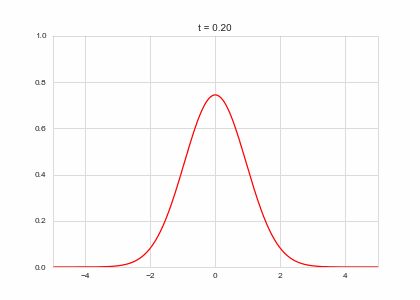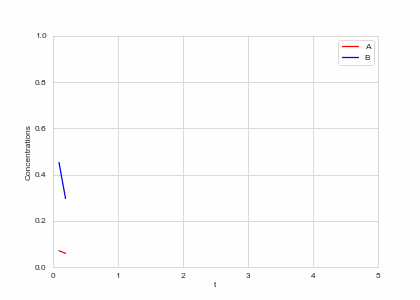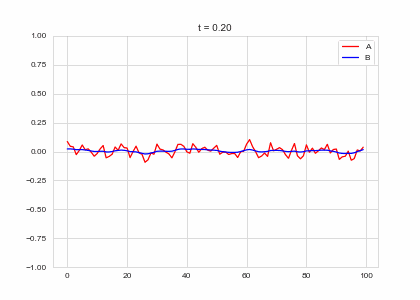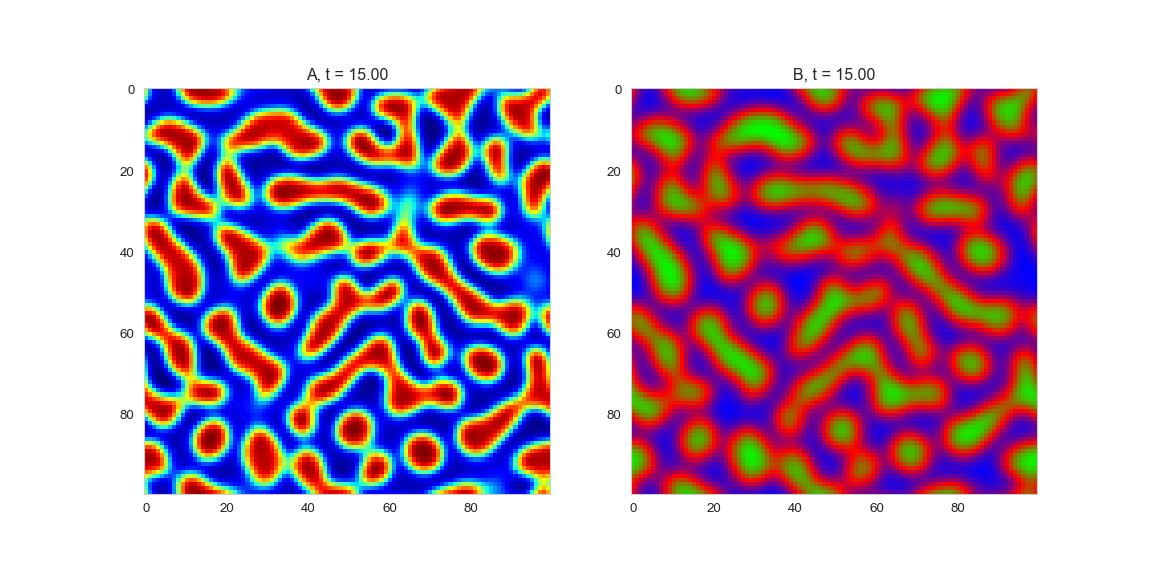import numpy as np
def laplacian1D(a, dx):
return (
- 2 * a
+ np.roll(a,1,axis=0)
+ np.roll(a,-1,axis=0)
) / (dx ** 2)
def laplacian2D(a, dx):
return (
- 4 * a
+ np.roll(a,1,axis=0)
+ np.roll(a,-1,axis=0)
+ np.roll(a,+1,axis=1)
+ np.roll(a,-1,axis=1)
) / (dx ** 2)Ch2 Lecture 1
Reaction-Diffusion Equations
Diffusion
Adapted from this blog post.
Last week, we talked about the diffusion equation. Here is the exact form:
\[\frac{\partial a(x,t)}{\partial t} = D_{a}\frac{\partial^{2} a(x,t)}{\partial x^{2}}\]
. . .
We approximated this using the finite-difference method:
Time derivative (which we had set to zero):
\[ \frac{\partial a(x,t)}{\partial t} \approx \frac{1}{dt}(a_{x,t+1} - a_{x,t}) \]
Spacial part of the derivative (which is usually know as the Laplacian):
\[ \frac{\partial^{2} a(x,t)}{\partial x^{2}} \approx \frac{1}{dx^{2}}(a_{x+1,t} + a_{x-1,t} - 2a_{x,t}) \]
. . .
This gives us the finite-difference equation:
\[ a_{x,t+1} = a_{x,t} + dt\left( \frac{D_{a}}{dx^{2}}(a_{x+1,t} + a_{x-1,t} - 2a_{x,t}) \right) \]
Boundary Conditions
Last week, with our metal rod, we had boundary conditions where the temperatures at the ends of the rod were fixed at 0 degrees.
We needed to say something about the boundaries to solve the system of equations.
Another option is periodic boundary conditions.
These are like imagining the rod is a loop, so the temperature at the end of the rod is the same as the temperature at the beginning of the rod.
Periodic Boundary Conditions: np.roll
Want an easy way to compute \(a_{x+1}\) for all \(x\)’s
Suppose we have n points, and we want to compute \(a_{x+1}\) for all \(x\)=n.
Problem: \(a_{x+1}\) would be off the end of the array!
Just replace \(a_{n+1}\) with \(a_{1}\)
Can do this easily with
np.roll. Lets us compute \(a_{x+1}\) for all \(x\)’s.
. . .
Laplacian with Periodic Boundary Conditions in Python
The autoreload extension is already loaded. To reload it, use:
%reload_ext autoreloadSolving and animating
class OneDimensionalDiffusionEquation(BaseStateSystem):
def __init__(self, D):
self.D = D
self.width = 1000
self.dx = 10 / self.width
self.dt = 0.9 * (self.dx ** 2) / (2 * D)
self.steps = int(0.1 / self.dt)
def initialise(self):
self.t = 0
self.X = np.linspace(-5,5,self.width)
self.a = np.exp(-self.X**2)
def update(self):
for _ in range(self.steps):
self.t += self.dt
self._update()
def _update(self):
La = laplacian1D(self.a, self.dx)
delta_a = self.dt * (self.D * La)
self.a += delta_a
def draw(self, ax):
ax.clear()
ax.plot(self.X,self.a, color="r")
ax.set_ylim(0,1)
ax.set_xlim(-5,5)
ax.set_title("t = {:.2f}".format(self.t))
one_d_diffusion = OneDimensionalDiffusionEquation(D=1)
one_d_diffusion.plot_time_evolution("diffusion.gif")Reaction Terms
We will have a system with two chemical components, \(a\) and \(b\).
Suppose \(a\) activates genes which produce pigmentation. \(b\) inhibits \(a\)
Will start with some random small initial concentrations of \(a\) and \(b\).
Each will diffuse according to the diffusion equation.
They will also react with each other, changing the concentration of each.
. . .
For the reaction equations, will use the FitzHugh–Nagumo equation
\(R_a(a, b) = a - a^{3} - b + \alpha\)
\(R_{b}(a, b) = \beta (a - b)\)
Where \(\alpha\) and \(\beta\) are constants.
Reaction Equation evolution at one point in space
class ReactionEquation(BaseStateSystem):
def __init__(self, Ra, Rb):
self.Ra = Ra
self.Rb = Rb
self.dt = 0.01
self.steps = int(0.1 / self.dt)
def initialise(self):
self.t = 0
self.a = 0.1
self.b = 0.7
self.Ya = []
self.Yb = []
self.X = []
def update(self):
for _ in range(self.steps):
self.t += self.dt
self._update()
def _update(self):
delta_a = self.dt * self.Ra(self.a,self.b)
delta_b = self.dt * self.Rb(self.a,self.b)
self.a += delta_a
self.b += delta_b
def draw(self, ax):
ax.clear()
self.X.append(self.t)
self.Ya.append(self.a)
self.Yb.append(self.b)
ax.plot(self.X,self.Ya, color="r", label="A")
ax.plot(self.X,self.Yb, color="b", label="B")
ax.legend()
ax.set_ylim(0,1)
ax.set_xlim(0,5)
ax.set_xlabel("t")
ax.set_ylabel("Concentrations")
alpha, beta = 0.2, 5
def Ra(a,b): return a - a ** 3 - b + alpha
def Rb(a,b): return (a - b) * beta
one_d_reaction = ReactionEquation(Ra, Rb)
one_d_reaction.plot_time_evolution("reaction.gif", n_steps=50)Full Model
We now have two parts: - a diffusion term that “spreads” out concentration - a reaction part the equalises the two concentrations. . . .
What happens when we put the two together? Do we get something stable?
def random_initialiser(shape):
return(
np.random.normal(loc=0, scale=0.05, size=shape),
np.random.normal(loc=0, scale=0.05, size=shape)
)
class OneDimensionalRDEquations(BaseStateSystem):
def __init__(self, Da, Db, Ra, Rb,
initialiser=random_initialiser,
width=1000, dx=1,
dt=0.1, steps=1):
self.Da = Da
self.Db = Db
self.Ra = Ra
self.Rb = Rb
self.initialiser = initialiser
self.width = width
self.dx = dx
self.dt = dt
self.steps = steps
def initialise(self):
self.t = 0
self.a, self.b = self.initialiser(self.width)
def update(self):
for _ in range(self.steps):
self.t += self.dt
self._update()
def _update(self):
# unpack so we don't have to keep writing "self"
a,b,Da,Db,Ra,Rb,dt,dx = (
self.a, self.b,
self.Da, self.Db,
self.Ra, self.Rb,
self.dt, self.dx
)
La = laplacian1D(a, dx)
Lb = laplacian1D(b, dx)
delta_a = dt * (Da * La + Ra(a,b))
delta_b = dt * (Db * Lb + Rb(a,b))
self.a += delta_a
self.b += delta_b
def draw(self, ax):
ax.clear()
ax.plot(self.a, color="r", label="A")
ax.plot(self.b, color="b", label="B")
ax.legend()
ax.set_ylim(-1,1)
ax.set_title("t = {:.2f}".format(self.t))
Da, Db, alpha, beta = 1, 100, -0.005, 10
def Ra(a,b): return a - a ** 3 - b + alpha
def Rb(a,b): return (a - b) * beta
width = 100
dx = 1
dt = 0.001
OneDimensionalRDEquations(
Da, Db, Ra, Rb,
width=width, dx=dx, dt=dt,
steps=100
).plot_time_evolution("1dRD.gif", n_steps=150)In two dimensions
Review of Matrix Arithmetic
Matrix Addition and Subtraction
Review matrix addition and subtraction on your own!
Matrix Multiplication
For motivation:
\[ 2 x-3 y+4 z=5 \text {. } \]
- Can write as a “product” of the coefficient matrix \([2,-3,4]\) and and the column matrix of unknowns \(\left[\begin{array}{l}x \\ y \\ z\end{array}\right]\).
. . .
Thus, product is:
\[ [2,-3,4]\left[\begin{array}{l} x \\ y \\ z \end{array}\right]=[2 x-3 y+4 z] \]
Definition of matrix product
\(A=\left[a_{i j}\right]\): \(m \times p\) matrix
\(B=\left[b_{i j}\right]\): \(p \times n\) matrix.
Product of \(A\) and \(B\) – \(A B\)
- is \(m \times n\) matrix whose
- \((i, j)\) th entry is the entry of the product of the \(i\) th row of \(A\) and the \(j\) th column of \(B\);
. . .
More specifically, the \((i, j)\) th entry of \(A B\) is
\[ a_{i 1} b_{1 j}+a_{i 2} b_{2 j}+\cdots+a_{i p} b_{p j} . \]
Reminder: Matrix Multiplication is not Commutative
- \(A B \neq B A\) in general.
Linear Systems as a Matrix Product
We can express a linear system of equations as a matrix product:
\[ \begin{aligned} x_{1}+x_{2}+x_{3} & =4 \\ 2 x_{1}+2 x_{2}+5 x_{3} & =11 \\ 4 x_{1}+6 x_{2}+8 x_{3} & =24 \end{aligned} \]
. . .
\[ \mathbf{x}=\left[\begin{array}{l} x_{1} \\ x_{2} \\ x_{3} \end{array}\right], \quad \mathbf{b}=\left[\begin{array}{r} 4 \\ 11 \\ 24 \end{array}\right], \quad \text { and } A=\left[\begin{array}{lll} 1 & 1 & 1 \\ 2 & 2 & 5 \\ 4 & 6 & 8 \end{array}\right] \]
. . .
\[ A \mathbf{x}=\left[\begin{array}{lll} 1 & 1 & 1 \\ 2 & 2 & 5 \\ 4 & 6 & 8 \end{array}\right]\left[\begin{array}{l} x_{1} \\ x_{2} \\ x_{3} \end{array}\right]=\left[\begin{array}{r} 4 \\ 11 \\ 24 \end{array}\right]=\mathbf{b} \]
Matrix Multiplication as a Linear Combination of Column Vectors
Another way of writing this system:
\[ x_{1}\left[\begin{array}{l} 1 \\ 2 \\ 4 \end{array}\right]+x_{2}\left[\begin{array}{l} 1 \\ 2 \\ 6 \end{array}\right]+x_{3}\left[\begin{array}{l} 1 \\ 5 \\ 8 \end{array}\right]=\left[\begin{array}{r} 4 \\ 11 \\ 24 \end{array}\right] . \]
. . .
Name the columns of A as \(\mathbf{a_1}, \mathbf{a_2}, \mathbf{a_3}\), then we can write the matrix as \(A=\left[\mathbf{a}_{1}, \mathbf{a}_{2}, \mathbf{a}_{3}\right]\)
. . .
Let \(\mathbf{x}=\left(x_{1}, x_{2}, x_{3}\right)\). Then
\[ A \mathbf{x}=x_{1} \mathbf{a}_{1}+x_{2} \mathbf{a}_{2}+x_{3} \mathbf{a}_{3} . \]
This is a very important way of thinking about matrix multiplication
Try it yourself
Try to find the solution for the following system, by trying different values of \(x_i\) to use in a sum of the columns of \(A\).
\[ A \mathbf{x} = \left[\begin{array}{lll} 1 & 1 & 1 \\ 2 & 2 & 5 \\ 4 & 6 & 8 \end{array}\right]\left[\begin{array}{l} x_1 \\ x_2 \\ x_3 \end{array}\right]=x_{1} \mathbf{a}_{1}+x_{2} \mathbf{a}_{2}+x_{3} \mathbf{a}_{3} =\left[\begin{array}{l} 6 \\ 21 \\ 38 \end{array}\right] \]
. . .
Now try changing the right-hand side to a different vector. Can you still find a solution? (You may need to use non-integer values for the \(x\)’s.)
This is a slightly changed system.
\[ A \mathbf{x} = \left[\begin{array}{lll} 1 & 1 & 2 \\ 1 & 2 & 2 \\ 4 & 6 & 8 \end{array}\right]\left[\begin{array}{l} x_1 \\ x_2 \\ x_3 \end{array}\right]=x_{1} \mathbf{a}_{1}+x_{2} \mathbf{a}_{2}+x_{3} \mathbf{a}_{3} =\left[\begin{array}{l} 11 \\ 12 \\ 46 \end{array}\right] \]
. . .
Are you able to find more than one solution? Can you find a right-hand-side that doesn’t have a solution?
Example: Benzoic acid
Benzoic acid (chemical formula \(\mathrm{C}_{7} \mathrm{H}_{6} \mathrm{O}_{2}\) ) oxidizes to carbon dioxide and water.
\[ \mathrm{C}_{7} \mathrm{H}_{6} \mathrm{O}_{2}+\mathrm{O}_{2} \rightarrow \mathrm{CO}_{2}+\mathrm{H}_{2} \mathrm{O} . \]
Balance this equation. (Make the number of atoms of each element match on the two sides of the equation.)
. . .
Define \((c, o, h)\) as the number of atoms of carbon, oxygen, and hydrogen atoms in the equation.
. . .
Next let \(x_1\), \(x_2\), \(x_3\), and \(x_4\) be the number of molecules of benzoic acid, oxygen, carbon dioxide, and water, respectively.
. . .
Then we have the equation
\[ x_{1}\left[\begin{array}{l} 7 \\ 2 \\ 6 \end{array}\right]+x_{2}\left[\begin{array}{l} 0 \\ 2 \\ 0 \end{array}\right]=x_{3}\left[\begin{array}{l} 1 \\ 2 \\ 0 \end{array}\right]+x_{4}\left[\begin{array}{l} 0 \\ 1 \\ 2 \end{array}\right] . \]
Rearrange:
\[ x_{1}\left[\begin{array}{l} 7 \\ 2 \\ 6 \end{array}\right]+x_{2}\left[\begin{array}{l} 0 \\ 2 \\ 0 \end{array}\right]=x_{3}\left[\begin{array}{l} 1 \\ 2 \\ 0 \end{array}\right]+x_{4}\left[\begin{array}{l} 0 \\ 1 \\ 2 \end{array}\right] . \]
becomes
\[ A \mathbf{x}=\left[\begin{array}{cccc} 7 & 0 & -1 & 0 \\ 2 & 2 & -2 & -1 \\ 6 & 0 & 0 & -2 \end{array}\right]\left[\begin{array}{l} x_{1} \\ x_{2} \\ x_{3} \\ x_{4} \end{array}\right]=\left[\begin{array}{l} 0 \\ 0 \\ 0 \end{array}\right] \]
We solve with row reduction:
\[ \begin{aligned} & {\left[\begin{array}{cccc} 7 & 0 & -1 & 0 \\ 2 & 2 & -2 & -1 \\ 6 & 0 & 0 & -2 \end{array}\right] \xrightarrow[E_{21}\left(-\frac{2}{7}\right)]{E_{31}\left(-\frac{6}{7}\right)}\left[\begin{array}{cccc} 7 & 0 & -1 & 0 \\ 0 & 2 & -\frac{12}{7} & -1 \\ 0 & 0 & \frac{6}{7} & -2 \end{array}\right] \begin{array}{c} E_{1}\left(\frac{1}{7}\right) \\ E_{2}\left(\frac{1}{2}\right) \\ E_{3}\left(\frac{7}{6}\right) \end{array} \left[\begin{array}{cccc} 1 & 0 & -\frac{1}{7} & 0 \\ 0 & 1 & -\frac{6}{7} & -\frac{1}{2} \\ 0 & 0 & 1 & -\frac{7}{3} \end{array}\right]} \\ & \begin{array}{l} \overrightarrow{E_{23}\left(\frac{6}{7}\right)} \\ E_{13}\left(\frac{1}{7}\right) \end{array}\left[\begin{array}{llll} 1 & 0 & 0 & -\frac{1}{3} \\ 0 & 1 & 0 & -\frac{5}{2} \\ 0 & 0 & 1 & -\frac{7}{3} \end{array}\right] \end{aligned} \]
. . .
\(x_{4}\) is free, others are bound. Now pick smallest \(x_4\) where others are all positive integers…
. . .
\[ 2 \mathrm{C}_{7} \mathrm{H}_{6} \mathrm{O}_{2}+15 \mathrm{O}_{2} \rightarrow 14 \mathrm{CO}_{2}+6 \mathrm{H}_{2} \mathrm{O} \]
Matrix Multiplication as a Function
Every matrix \(A\) is associated with a function \(T_A\) that takes a vector as input and returns a vector as output.
\[ T_{A}(\mathbf{u})=A \mathbf{u} \]
. . .
Other names for \(T_A\) are “linear transformation” or “linear operator”.
Transformations
Scaling
Goal: Make a matrix that will take a vector of coordinates \(\mathbf{x}\) and scale each coordinate \(x_i\) by a factor of \(z_i\).
\[ A x = \left[\begin{array}{ll} a1 & a2 \\ a3 & a4 \end{array}\right] \left[\begin{array}{l} x_1 \\ x_2 \end{array}\right] = \left[\begin{array}{l} z_1 \times x_1 \\ z_2\times x_2 \end{array}\right] \]
. . .
\[ A = \left[\begin{array}{ll} z_1 & 0 \\ 0 & z_2 \end{array}\right] \]
Shearing
Shearing: adding a constant shear factor times one coordinate to another coordinate of the point.
Goal: make a matrix which will transform each coordinate \(x_i\) into \(x_i + \sum_{j \ne i} s_{j} \times x_j\).
\[ A x = \left[\begin{array}{ll} a1 & a2 \\ a3 & a4 \end{array}\right] \left[\begin{array}{l} x_1 \\ x_2 \end{array}\right] = \left[\begin{array}{l} x_1 + s_2 x_2 \\ x_2 + s_1 x_1 \end{array}\right] \]
. . .
\[ A = \left[\begin{array}{ll} 1 & s_2 \\ s_1 & 1 \end{array}\right] \]
Example
Let the scaling operator \(S\) on points in two dimensions have scale factors of \(\frac{3}{2}\) in the \(x\)-direction and \(\frac{1}{2}\) in the \(y\)-direction.
Let the shearing operator \(H\) on these points have a shear factor of \(\frac{1}{2}\) by the \(y\)-coordinate on the \(x\)-coordinate.
Express these operators as matrix operators and graph their action on four unit squares situated diagonally from the origin.
Solution
- Scaling operator \(S\):
. . .
\[ S((x, y))=\left[\begin{array}{c} \frac{3}{2} x \\ \frac{1}{2} y \end{array}\right]=\left[\begin{array}{cc} \frac{3}{2} & 0 \\ 0 & \frac{1}{2} \end{array}\right]\left[\begin{array}{l} x \\ y \end{array}\right]=T_{A}((x, y)) \]
. . .
Verify:
- Shearing operator \(H\):
\[ H((x, y))=\left[\begin{array}{c} x+\frac{1}{2} y \\ y \end{array}\right]=\left[\begin{array}{ll} 1 & \frac{1}{2} \\ 0 & 1 \end{array}\right]\left[\begin{array}{l} x \\ y \end{array}\right]=T_{B}((x, y)) \]
Verify
Concatenation of operators \(S\) and \(H\)
The concatenation \(S \circ H\) of the scaling operator \(S\) and shearing operator \(H\) is the action of scaling followed by shearing.
Function composition corresponds to matrix multiplication
. . .
\[ \begin{aligned} S \circ H((x, y)) & =T_{A} \circ T_{B}((x, y))=T_{A B}((x, y)) \\ & =\left[\begin{array}{cc} \frac{3}{2} & 0 \\ 0 & \frac{1}{2} \end{array}\right]\left[\begin{array}{ll} 1 & \frac{1}{2} \\ 0 & 1 \end{array}\right]\left[\begin{array}{l} x \\ y \end{array}\right]=\left[\begin{array}{cc} \frac{3}{2} & \frac{3}{4} \\ 0 & \frac{1}{2} \end{array}\right]\left[\begin{array}{l} x \\ y \end{array}\right]=T_{C}((x, y)), \end{aligned} \]
Verify
Rotation
Goal: rotate a point in two dimensions counterclockwise by an angle \(\phi\). Suppose the point is initally at an angle \(\theta\) from the \(x\)-axis.
\[ \left[\begin{array}{l} x \\ y \end{array}\right] =\left[\begin{array}{l} r \cos \theta \\ r \sin \theta \end{array}\right] \]
We can use trigonometry to find the values of x and y after rotation.
\[ \left[\begin{array}{l} x^{\prime} \\ y^{\prime} \end{array}\right] =\left[\begin{array}{l} r \cos (\theta+\phi) \\ r \sin (\theta+\phi) \end{array}\right]=\left[\begin{array}{l} r \cos \theta \cos \phi-r \sin \theta \sin \phi \\ r \sin \theta \cos \phi+r \cos \theta \sin \phi \end{array}\right] \]
. . .
Using the double-angle rule,
\[ =\left[\begin{array}{rr} \cos \theta &-\sin \theta \\ \sin \theta & \cos \theta \end{array}\right]\left[\begin{array}{l} r \cos \phi \\ r \sin \phi \end{array}\right]=\left[\begin{array}{rr} \cos \theta&-\sin \theta \\ \sin \theta & \cos \theta \end{array}\right]\left[\begin{array}{l} x \\ y \end{array}\right] \]
. . .
So we define the rotation matrix \(R(\theta)\) by
\[ R(\theta)=\left[\begin{array}{rr} \cos \theta & -\sin \theta \\ \sin \theta & \cos \theta \end{array}\right] \]






